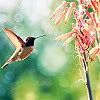
- There are more than 300 types or species of hummingbirds. Most of the types or species of hummingbirds are found in South America. The county of Ecuador has the largest number of types or species of hummingbirds.
- There are two sub-families of hummingbirds:
- Hummingbirds are the smallest birds in the world.
- Hummingbirds can flash their radiant, beautiful colors, as well as camouflage themselves when needed.
- A hummingbird's brain is 4.2% of its body weight, it's considered to be the largest proportion in the kingdom of birds. Hummingbirds are very intelligent. They can remember every flower they've ever been to and how long it will take that flower to refill.
- Hummingbirds can hear better and see further than humans. With being able to see further, they can also see ultraviolet light.
- Even though they have distinct hearing and sight, their sense of smell is very little. They have little to no smelling ability.
- A hummingbird's tongue is grooved like the shape of a "W." They use their tongues to lap up nectar from flowers and feeders. They have little hairs on the tip of their tongues to help them get nectar with ease. Hummingbirds don't drink through their beaks like a straw, they lap up nectar with their tongues.
- A hummingbird's beak is just as similar as any other bird's beak, it's just longer in proportion to its body. The edges of the hummingbird's top beak overlap the edges of the bottom of its beak. A hummingbird's bottom beak is also slightly flexible.
- Hummingbird heart beats measure up to 1,260 times per minute. A hummingbird's heart beats 250 times per minute at rest. Their hearts are also 2.5% of their total body weight.
- A hummingbird's metabolism is roughly 100 times that of an elephant.
- Hummingbirds have very weak feet and can barely walk. Hummingbirds prefer to just fly.
- Hummingbird wings beat about 70 times per second. Hummingbird's wings will beat up to 200 times per second when diving.
- Hummingbirds are the only birds that can fly both forward and backwards. Hummingbirds can also hover in mid-air, fly sideways and even upside-down.
- A hummingbird can fly an average of 25-30 miles per hour.
- A hummingbird can dive up to 60 miles per hour. A hummingbird's wings will rotate in a full circle.
- Hummingbirds love to perch. They do it for most of their life.
- A hummingbird's body temperature is around 107 degrees Fahrenheit.
- Hummingbirds are on an average of 8.5 centimeters long from the tip of their beak to their tail.
- A hummingbird can weigh anywhere between 2 and 20 grams.
- A penny weighs 2.5 grams.
- 30% of a hummingbird's weight consists of their flight muscles.
- Humans pectoral muscles are about 5% of their body weight.
- Female hummingbirds are generally larger than males.
- An average sized hummingbird has about 940 feathers.
- Female hummingbirds find iridescent feathers attractive.
- Male hummingbirds are very aggressive.
- Female hummingbirds do all the nest building. Female hummingbirds typically lay a clutch of two eggs. Males do not help raise the young.
- Baby hummingbirds are generally smaller than a penny. They can not fly at birth. They remain in the nest for three weeks.
- Most hummingbirds die their first week of life.
- Hummingbirds have an average life span of about five years, yet they can live longer than ten.
- The Broad-Tailed Hummingbird is the oldest known hummingbird captured and tagged twelve years apart.
- Ruby-Throated Hummingbirds have been known to travel 500 miles over the Gulf of Mexico to breeding grounds.
- It is estimated that a Ruby-Throated Hummingbird takes about twenty hours to fly across the Gulf of Mexico.
- Some hummingbirds will travel over two-thousand miles twice a year during migration times.
- The Rufous Hummingbird travels the farthest north of any other hummingbird during migration. All the way from Mexico to Alaska.
- Hummingbird DO NOT migrate on the backs of geese.
- Geese fly on different migration paths or fly-zones than hummingbirds do.
- Hummingbirds need to eat on average 7 times per hour for about 30-60 seconds. A hummingbird can eat anywhere from half to eight times its body weight a day. Hummingbirds eat small soft bugs for protein.
- When hummingbirds sleep at night, they go into a hibernation-like state called torpor. Hummingbirds enter torpor to conserve energy. When a hummingbird goes into torpor, their metabolic rate is one-fifteenth of normal sleep. Torpor can save up to 60% of a hummingbird's available energy. When in torpor, and hummingbirds heart rate can drop to as few as 50 beats per minute. During torpor, a hummingbird can lower the body temperature to as low as 70 degrees Fahrenheit. When hummingbirds go into torpor, they will appear as if they are dead and have occasionally been found to be hanging upside-down. It can take up to an hour for a hummingbird to fully recover from torpor.
- Hummingbirds are only found in the Americas.
- Hummingbirds are found as far north as Alaska and as far south as Chile.
- Hummingbirds are the second largest family of birds in the Western Hemisphere.
- There are more than fifty types or species of hummingbirds that breed in Mexico.
- There are more than fifteen types or species of hummingbirds that breed in the United States.
- There are more than three types or species of hummingbirds that breed in Canada.
- Names for hummingbirds in other parts of the world include:
- Beija-Flor: Portuguese for Flower-Kisser
- Chupaflor: Spanish for Flower-Sucker
- Joyas Voladoras: Spanish for Flying-Jewels
- Picaflor: Spanish for Flower-Nibbler
- El Zunzun: Caribbean for The Hummer
jan 19 2013 ∞
jan 29 2013 +